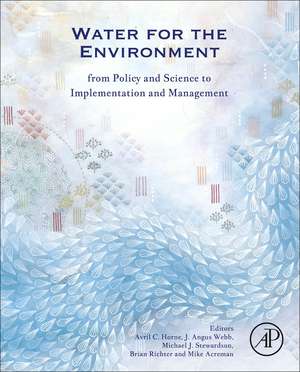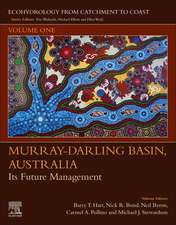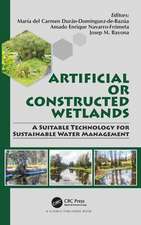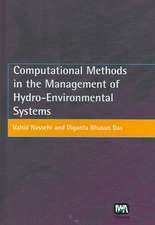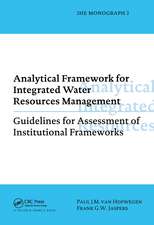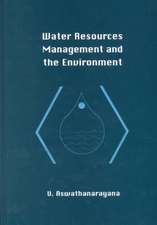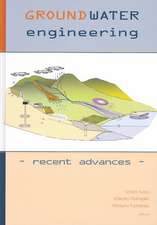Water for the Environment: From Policy and Science to Implementation and Management
Editat de Avril Horne, Angus Webb, Michael Stewardson, Brian Richter, Mike Acremanen Limba Engleză Paperback – 16 aug 2017
The book highlights current challenges and potential solutions, helping define the future direction for environmental water management. In addition, it includes a significant review of current literature and state of knowledge, providing a one-stop resource for environmental water managers.
- Presents a multidisciplinary approach that allows water managers to make connections across related disciplines, such as hydrology, ecology, law, and economics
- Links science to practice for environmental flow researchers and those that implement and manage environmental water on a daily basis
- Includes case studies to demonstrate key points and address implementation issues
Preț: 815.46 lei
Preț vechi: 1063.30 lei
-23% Nou
Puncte Express: 1223
Preț estimativ în valută:
156.06€ • 169.45$ • 131.09£
156.06€ • 169.45$ • 131.09£
Carte tipărită la comandă
Livrare economică 15-29 aprilie
Preluare comenzi: 021 569.72.76
Specificații
ISBN-13: 9780128039076
ISBN-10: 0128039078
Pagini: 758
Dimensiuni: 191 x 235 x 41 mm
Greutate: 1.5 kg
Editura: ELSEVIER SCIENCE
ISBN-10: 0128039078
Pagini: 758
Dimensiuni: 191 x 235 x 41 mm
Greutate: 1.5 kg
Editura: ELSEVIER SCIENCE
Cuprins
Section I: Introduction
1. Introduction
Section II: History and context of environmental flows
2. Drivers and social context
3. Understanding hydrological alteration
4. Ecological effects of hydrologic alteration
5. Geomorphological change
Section III: Vision and objectives for the river system
6. Impacts of Hydrological Alterations on Water Quality
7. Stakeholder Engagement in Environmental Flows Management
8. Environmental flows and natural capital – free-flowing ecosystem services
9. Environmental water management’s cultural challenge
10. Environmental flow objectives and targets
Section IV: How much water is needed? Tools for environmental water development
11. Evolution of flow principles and methodologies
12. Tools for sediment
13. Physical habitat modelling and ecohydrological tools
14. Ecological response modelling
15. Determining and addressing uncertainty
Section V: Environmental water within Water Resource Planning
16. Water Budgets to Inform Sustainable Resource Management
17. Mechanisms to allocate environmental water
18. Rebalancing the system - Acquiring water and trade
19. Environmental Water Organizations and Institutional Settings
20. Management options informed by hydrological drivers
21. Managing Infrastructure to Maintain Natural Functions in Developed Rivers
22. Environmental water and integrated catchment management
Section VI: Active management of environmental water
23. Planning the use of environmental water
24. Operational issues
25. Monitoring, evaluation and adaptive management of environmental flows
26. Performance Management: A Multi-criteria Policy Toolkit
Section VII: Remaining challenges and way forward
27. Where to from here
1. Introduction
Section II: History and context of environmental flows
2. Drivers and social context
3. Understanding hydrological alteration
4. Ecological effects of hydrologic alteration
5. Geomorphological change
Section III: Vision and objectives for the river system
6. Impacts of Hydrological Alterations on Water Quality
7. Stakeholder Engagement in Environmental Flows Management
8. Environmental flows and natural capital – free-flowing ecosystem services
9. Environmental water management’s cultural challenge
10. Environmental flow objectives and targets
Section IV: How much water is needed? Tools for environmental water development
11. Evolution of flow principles and methodologies
12. Tools for sediment
13. Physical habitat modelling and ecohydrological tools
14. Ecological response modelling
15. Determining and addressing uncertainty
Section V: Environmental water within Water Resource Planning
16. Water Budgets to Inform Sustainable Resource Management
17. Mechanisms to allocate environmental water
18. Rebalancing the system - Acquiring water and trade
19. Environmental Water Organizations and Institutional Settings
20. Management options informed by hydrological drivers
21. Managing Infrastructure to Maintain Natural Functions in Developed Rivers
22. Environmental water and integrated catchment management
Section VI: Active management of environmental water
23. Planning the use of environmental water
24. Operational issues
25. Monitoring, evaluation and adaptive management of environmental flows
26. Performance Management: A Multi-criteria Policy Toolkit
Section VII: Remaining challenges and way forward
27. Where to from here
